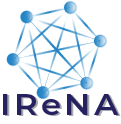REACLIB Help
Main Page > > Results Page > Frequently Asked QuestionsFrequently Asked Questions
- How are reverse rates calculated? or What does the "v" flag mean?
The "v" flag in REACLIB format, shows rates (reverse rates) in which detailed balance (without partition functions) was used to derive the reaction rate. Therefore, rates with this flag must be corrected to include partition function modifications. - How do I suggest a reaction?
To suggest a reaction, click on "Update Status" under "Status/Discussion". This brings up the workflow diagram. Click on "Suggest A Rate" under the New Rates section. This brings you to the suggestion page. Select the chapter the rate belongs to from the drop down box, then enter the nuclides involved in the reaction. Then fill out the information source and any comments. You will need to enter your name and email address before you submit the suggestion. - What are future rates?
Future rate versions are used to keep track of versions that are in the system but are not yet suggested for use. This allows users to comment on rates before they are recommended. Future rate versions will be shaded green on the results page. - Why is it when I download a REACLIB file without chapters 9,10, and 11 the chapter 9 rates are still downloaded but as chapter 8 rates?
This is due to the fact that chapter 8 used to include two types of reactions. We broken the rates off into two chapters (8 and 9) so the chapters were more consistent. However, in order to preserve backwards compatibility we need to output the chapter 9 rates as chapter 8 rates. - What do Al-6 and Al*6 mean?
Al-6 refers to the ground state of Al26, and Al*6 refers to the meta-stable state of Al26. Al26 refers to the thermal population of Al-6 & Al*6. - How are the ground state weak decays entered into the database?
These are entered under the labels wc07 & mo03. These weak rates are the partial decay rates, not total rates. Beta-delayed particle emission is presented in the database. - How do I treat the pp->d weak reactions?
The 2 rates presented are labeled "ec" and "bet+". They must be accounted for specially (as they aren't beta-decays or electron captures). - How do new thermonuclear reaction rates get into the database?
- Rates are recommended from astrophysics community.
- By submission on our status page or by direct contact.
- Found by the JINA VJ
- Submitted to nucastrodata.org repository
- Committee decides what to do with rates
- Put directly into database
- Rate needs evaluation before entry
- Rate needs comparison before entry
- Can be left out
- New rates are put into the database as "Future Versions".
- These Future Rates are then independently compared to "source" data-points.
- If agreement is within 5% it is "Verified"
- Otherwise, rates are presented as known deviations to be fixed
- Committee then approves future rates that have been verified.
- Committee decides if new version supplants current recommended rate.
- Otherwise it just becomes a new rate version to choose from.
- Rates are recommended from astrophysics community.
- How are reaction rates verified?
- Every Week the Database is downloaded for independent offline verification.
- Repeat verification of older rates
- New rates are found for verification ("Future" versions)
- Labels of new rates used to find "source" information
- Relevant papers downloaded
- Data files presenting evaluation information downloaded
- Stellar Enhancement Factors (SEFs) are downloaded
- Info used to create "source" data table of reaction rates
- "Source" data-points are compared with rates from the database
- Rates deviating by more than 5% are flagged
- Rate labels not checked printed to file
- Deviation files sent to verification team
- Team checks derived source data-points
- Examines possible explanations for deviations
- Source data errors are fixed and compared to database rates again
- Verification team-checked deviation files then sent to REACLIB rate team
- Rate team checks their own entries for deviant reaction rates
- Rates fixed and rechecked
- Any remaining deviations must be commented on why they can be allowed
- These comments are then added to the rate details page
- Final deviations file uploading to "Known Problems" page
- Every Week the Database is downloaded for independent offline verification.
If you have any reaclib/database questions or problems please email us. Send Email
Last updated by cyburt on November 16th 2010 at 12:42

